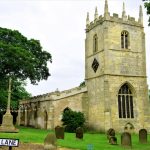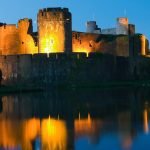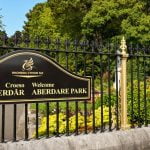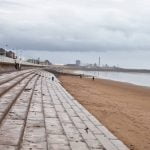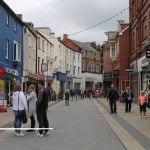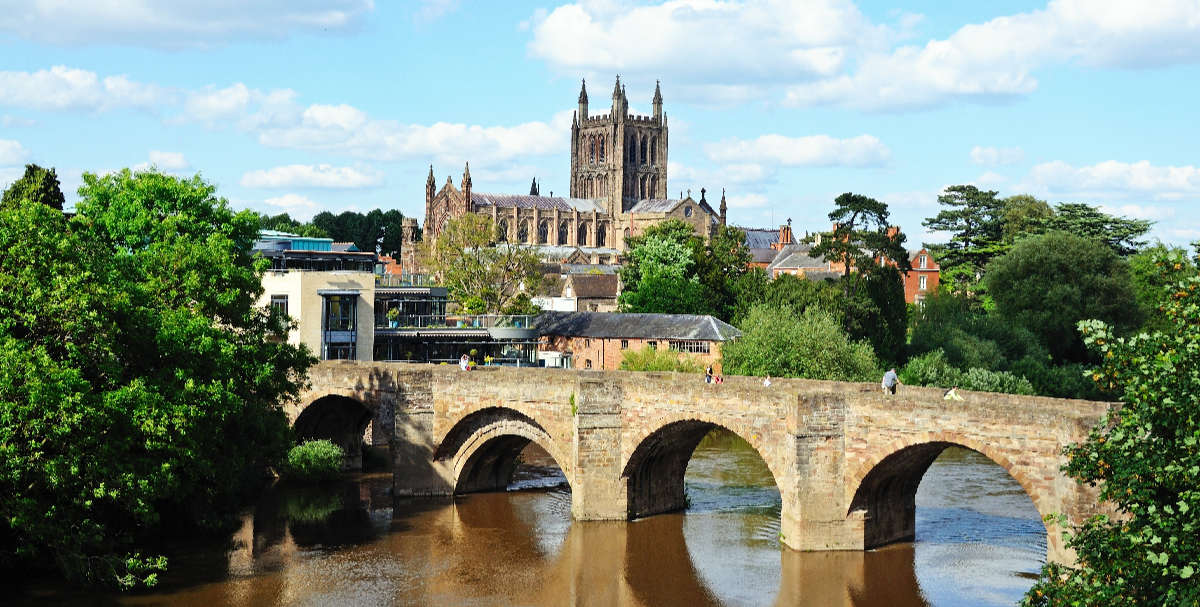
Stuck for somewhere new to visit? Then here is why Hereford should be on your list…
Situated on the River Wye and only a stone’s throw from the Welsh border, Hereford is another of those hidden staycation gems. Historically it had a troublesome past battling off Welsh invaders but nowadays its is better known for its idyllic setting, beautiful Cathedral, and of course Cattle. If you are lucky enough to find yourself in Herefordshire then you must pay it a visit and of course, it’s a great base to explore the region.
Ok, that’s enough preamble lets get started by having a look at the history that made the town what it is today, then we will talk about the attractions you might find in Herefordshire. Let’s start with the olden days. What’s hidden in Herefordshire past?
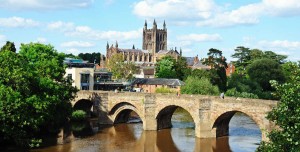
Image: Caron Badkin/Shutterstock.com
Hereford’s Early History
Although most people will tell you that Hereford was ‘born’ in Saxon times, we are going to disagree a little. Its name comes either from the Welsh words for an old Roman road or from the Anglo-Saxon words for an army that crossed a shallow point in a river. Since the two sides of the border were at war for hundreds of years, we can only assume it is a combination of both. The fact that the Roman settlement of Stretton Sug was was nearby, reveals that the area was likely inhabited in the first few centuries AD.
Nevertheless, records have the town of Hereford as being occupied by the Saxons when they arrived in this part of England, circa 600 AD. A town grew around the ford, which was later placed under the control of a Bishop. By the 8th century, Hereford was massive and became the centre of West Mercia before England united to become the land, we know it as today.
Hereford made good trade from both the Saxons and the Welsh. Its position on the border means that it was often debated as to who owned it. Some documents say it is a Welsh town, some say English. We say it depended on who had the bigger army at the time! For the most part, however, Hereford was English.
The Battle(s) of Hereford
The first noteworthy battle recorded here was in 760. Aptly named the “Battle of Hereford” it was a square-off between the neighbouring Welsh Kingdoms and the forces of Wessex. This was not the last spat between the two and in 1056, Edward the Confessor (and historically renowned rubbish king) along with his Viking allies amassed there to invade Wales. It was not a good idea as they were well beaten and the poor people of Hereford paid the price. Like we say… He was a rubbish king.
Hereford wasn’t done having a fascinating early history yet, though, and threw up a Cathedral in the 12th century. They added the first bridge across the river then, too. This was about a hundred years after William the Conqueror invaded and stole England. In the Domesday Survey conducted in 1086, the town of Hereford had two owners and numerous villagers. They had smallholders, plough teams, two slaves and three female slaves. The church kept slaves in those days.
The land was worth £2 and ten shillings to one landowner, and £7, 6 shillings and 12 pence to the other. Coincidentally, both of the owners were the Bishop of St Mary. England might have been invaded, but the church was left alone.
Medieval Times in Hereford
Fortifications before Danelaw kicked in meant that Hereford was already a Burh – a fortified town – when Alfred the Great lived in the 9th century. After the Norman invasion, the town had taken in refugees from all over the world. There was a thriving Jewish community, for example, and those that couldn’t find peace in either Wales or England could find it here in the steadily growing border and market town.
A stone bridge replaced the wooden bridge in 1100, then the town was granted a king’s charter at the end of the 12th century. This let them pave and clean the streets, hold a market, and later to light the streets, provide piped water and take away sewage.
In 1256, a quay was added, and the town was making leather goods aplenty. Wool, dye, and even soap making were all trades in Hereford. The 13th century saw many friars arrive and populate the area. The Jews were expelled in 1290 and the friars in the 16th century, by Henry VIII. The 12th and 13th centuries saw the Hospital of St John erected and a leper hostel grow near the town. A Bishop was buried here in the 12th century too, only to later be declared a saint. People flocked to the town to see miracles by his graveside.
In the 16th century, Hereford had a population sitting at about 5,000 people and was described as strong-walled with a tough castle. It had to be, to keep out all the attacks by the Welsh over time (sorry Wales). Nevertheless, disease worked its way in, leading to outbreaks of plague three times in a hundred years. An Alms-house went up in 1630, with a second hospital added in 1614.
The Civil War
In the English Civil War, Hereford sided with the king but was invaded many times… despite the strong walls. The castle on the border with Wales was seen as an important defence point. It went back and forth a fair amount. In 1645, a siege lasted from July to September – but failed. Two months later, the town was forced into submission anyway because the king lost.
Before the start of the Industrial Era, wool fulling had gone into decline and brewing was on the rise. Hereford had plenty of apples, having always been known as a market town that sells produce from the surrounding countryside. They went into cider making and never looked back.
Let’s take a break from all that hard-fought history before the Industrial Revolution kicks in. We want to learn some fun trivia from Hereford, to keep us entertained.
Fun Hereford Trivia
In a town with such a vast history spanning so many years, it’s a done deal that there will be plenty of fun facts to amuse ourselves with inside. Let’s talk fun facts… what’s Hereford got to show for itself?
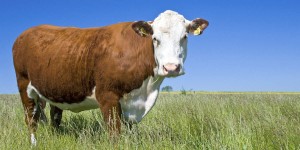
Image: visuall2/Shutterstock.com
- Hereford Cattle are world-famous – honest! The pedigree comes from an illustrious lineage that was begun in Herefordshire, in 1742. The cows can be traced back down the line to their ancestry. Something even people can’t always do.
- Bulmer’s the cider maker has the biggest cider making factory in the world. It was opened in 1975 and can hold 15 gallons of cider.
- There is an (untested – please don’t test it) ancient law that says it is legal to shoot a Welshman in Cathedral Close in Hereford. There are two conditions. You must shoot them with a longbow, and you must do it on a Sunday. What even…?
- Hereford was an early mint town, back before England became England. It’s literally older than sliced bread.
That’s right, Hereford is a pretty interesting place to have come from – or to visit on holiday in the UK. Pop in, you are just over the border from some lovely Welsh countryside, and they have cider enough to fill a swimming pool with.
The Industrial Age in Hereford
Hereford started the Industrial Era as a pleasant large town with a population recorded at 5,592. Daniel Defoe was here in 1720 something and called it dirty. 1710 saw another school open, with the end of that year allowing a town council in charge of cleaning it up. The gates were eventually brought down as roads needed to be wider, although the names of the areas of the town stuck. The end of the 18th century saw a whole tower of the cathedral fall in, needing to rebuild. Fortunately, no injuries are recorded.
Hereford had a castle once, but it was taken down in the 18th century. By the end of the 19th century, changes had seen the population swell to 21k. In 1863, gas lamps lit the streets. In 1849 it opened the fire brigade, and in 1856, a waterworks was built. The butter market opened in 1860 to sell local produce and 1899 saw electricity in town. The gas lamps were shortly replaced.
A canal, added in 1845, saw more business and wealth brought to the area. It was used up until 1880. In 1854, a railway station opened. A museum, library, and several churches went up in the area. Cider making, boat building, brewing, leatherworking, and meat, were the main trades throughout the industrial period. Although the population grew, it didn’t skyrocket as other towns might have.
2oth Century Hereford
After 1900, a town hall was built, a College of Education was added, and the First World War took many young men to their deaths. A war memorial was added in 1922 and everyone swore it wouldn’t happen again. In 1931, the population was 24k, swelling to 47k in the 70s.
In 1916 there was a tragedy in town. Eight young girls were killed when performing in a charity concert at the Garrick Theatre after a fire broke out. A group of 13 school children were dressed in Eskimo and Snow Maiden costumes. While leaving the stage, their costumes (made from cotton wool despite this being illegal in the theatre) caught fire. 13 children went up in flames and 6 died. Two later died in hospital. They had been performing to raise funds for two local regiments.
There were multiple improvements made in Hereford over the course of the 20th century. A hospital opened in 1940, just before the Second World War stole yet more young men from us. Hereford Tech opened as a college in 1949, to give the next generation some hope. Hereford Cider Museum was built in 1981 and the Mappa Muni library was opened in 1996. An arts centre followed two years later.
Today it has a population of about 61,000 people, making it the county seat and largest town in Herefordshire by some way.
Modern Hereford
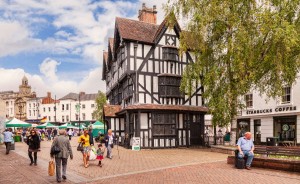
Image: travellight/Shutterstock.com
Modern times see Hereford a town responsible for packaging and shipping produce from around the local countryside. It is a rural marvel, like a glittering jewel in a craft cider and artisan relish crown. They can food here, make furniture, brew alcohols and make bricks. It has become a town of antiquity, quietly plodding along while feeding on the detritus of the tourist destined for Wales.
Do we recommend it as somewhere to visit if you are coming to England? Absolutely. Do we recommend it to those who are looking for a staycation destination? Yes, we do. There’s not a lot about the modern town of Hereford that we don’t like, actually, and we are certain you will find it the same. Go see. Tell them Five Minutes Spare sent you and feel free to put that in a hashtag.
Let’s look at who the most famous people from Hereford are, before we move on to the best things to see and do in town.
Famous People from Hereford
If you are doing your holiday shopping while in Hereford, there are many famous people out there that you might run into. Here are the Five Minutes Spare favourite famous people from Hereford, to keep an eye out for in the supermarket:
- Dermot O’Leary, the presenter of the X-Factor, is a Hereford man.
- Singer and songwriter Ellie Golding is from Hereford.
- Pro footballer Connor Wickham is from here, and Jarrod Bowen was born nearby.
- Frank Oz was born here, and he voiced several Muppets.
- The artist Peter Ford comes from here, too.
There is a whole load of famous faces to have emerged from Herefordshire over the years. Look at the full list over on Wikipedia if you are interested.
Hereford Attractions
Wondering what the best things to see and do in Hereford are? Check out the following attractions and add the ones you like best to your Hereford holiday itinerary.
Historic Sights and Landmarks
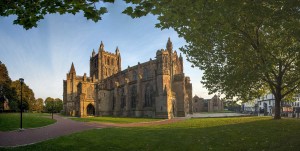
Image: freedom100m/Shutterstock.com
Hereford Cathedral has been in the making since the 12th century. Nowadays, it not only holds services on a Sunday but is also makes one of the biggest, best landmarks in Hereford. The Cathedral is massive, striking, and makes an excellent backdrop for your Instagram photos.
The Cathedral is also home to the Mappa Mundi – the largest medieval map of England that the church holds. It is written on a calfskin, which is a bit sick, but they were short of paper back then. The map was made in or around the year 1300, proving that Hereford has been a town of great promise for many a century.
Next on the list of interesting sights to see in and around Hereford is Berrington Hall. If you go at wintertime, expect to see the house draped in tinsel and spectacular Christmas trees. If you go in summer, take advantage of the beautiful weather to explore the grounds. They have been landscaped to perfection on this Georgian manor house site.
Galleries and Museums
There is only one museum in Hereford that you need to know about… the Hereford Cider Museum. This has bottles from numerous years of cider production, both empty and filled. It has a history of cider making in the county, it has documents signed by the first cider barons… if you like apples, you will love their exhibitions. The cider museum was first opened in 1973 and grew from a private collection into something so monstrous that it needed its own building.
If you are more about staying in the town centre, then have a look at the Black and White House Museum. This place is a fascinating example of the old 17th century timber-framed homes. It was originally built back in 1621 as a butcher’s shop. Later, it was used by Lloyds Bank up until 1929, when it was converted into a period-style house museum. It’s exceptionally beautiful and you feel that you have stepped back in time.
Hereford has a waterworks museum and we’re not sure what we make of it. Those that are interested in the history of engineering might enjoy it but learning about water pipes and the evaporation cycle is a bit beyond us. Nevertheless, they see thousands of tourists every year and make a fortune from school groups and university visitors. Many of the exhibits are child-friendly and interactive and kids under 16 go free.
Shopping and Retail
Although not wholly a shop, the Chase Distillery is one of the top spots to shop in town. Take the tour and have a tasting session. They mainly distil vodka and gin, but you might find a few other treats in their gift shop. Needless to say, this one is adults only…
Another weird retail option is the Monkland Cheese Dairy. They produce cheeses to die for and let you taste it in their shop with the little crackers that cleanse your palate. It’s awesome to see cheese being made. They also have a café attached so you can sample the wares alongside a nice cup of tea. They do cheese tours, experience days where you get stuck into the cheese-making yourself, and the occasional event.
Outdoor Attractions
Those that like some outdoor time, will love the Weir Garden. It is run by the National Trust and it sits on the banks of the river Wye. Although originally an old garden from the Victorian age, the Weir garden has been renovated and refurbished by a team of dedicated volunteers. Get involved if you live nearby. If you are just visiting, enjoy the peace and serenity the garden holds. Book in advance though, just to be safe.
If that’s not enough gardening for you, head to the Brobury House Gardens. There are a little more user-friendly for those with mobility issues. There are solid pathways and plenty of seating areas. It’s a lovely Victorian house in the sort of miniature manor-style that you find in fairy stories. If you’re lucky enough, you will get to see the bluebells in spring, or witness a wedding while you stroll the greenhouses.
Hereford’s not done yet with the gardens. Visit the Kenchester Water Gardens to enjoy some fountains with your plants. They have more trees than the other two. Since it is a water gardens, they have lots of fish and food you can feed them, including a tropical koi pond. If you keep an aquarium you will love this.
Sports and Recreation
Hereford FC is the team of the town here. Visit them for a stadium tour, get a guided club house walk around, take some pics of your favourites, catch a game, or just add it to your IG timeline as if you went there.
As for golf, there is the Burghill Valley Golf Club out to the north of town. You could also check out the Halo Golf Course, or the Herefordshire Golf Academy. All are at your disposal in Merry Hereford.
Other Notable Attractions
There are so many places of interest in Hereford that we couldn’t fit them all into one place. Instead, we added this section to cover the sights that didn’t quite make the cut, that little bit more briefly. Here are some of our other favourite Hereford attractions:
- The Courtyard Theatre regularly runs shows.
- The Kentchurch Court allotments are a nice walk.
- Visit the Ciolette Szabo GC Museum, it’s pure weirdness.
- The Hereford Buttermarket is a great flea market to visit.
So, there should be something to do in town for all the family. If not, Wales is only a few miles west.
How to Get There?
We can talk about attractions all we like. If we don’t tell you how to get to the darned place, you might never get to enjoy them. Here are some loose instructions to help you get to Hereford.
By Road
Take the M5 out of Birmingham to the south.
By Rail
GWR go through Hereford and the national station is HFD.
By Air
Look for Bristol International Airport.
By Sea
There’s no sea access but you could sail the Wye.
Got Spare Time?
If you are still stuck for some awesome places in the UK to visit for a staycation, then have no fear. Five Minutes Spare has covered numerous destinations for you to get to grips with. No matter whether you want to party it up in Manchester, or take a city break in Edinburgh, we have it all if you have the five minutes to read it.
